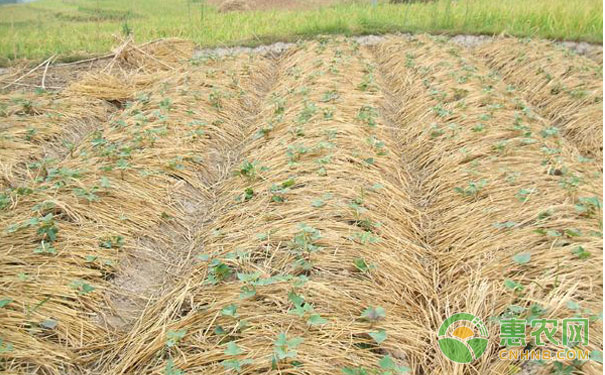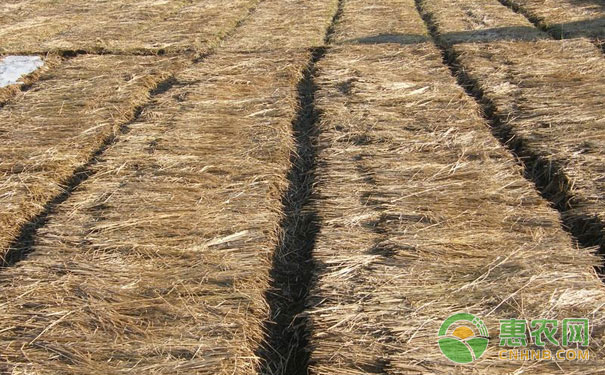New technology of potato planting in paddy field no-tillage straw
Potatoes are called potatoes and artichokes. Autumn potato is a late autumn crop with a high commodity rate. In particular, the straw-covered autumn potato not only has the characteristics of saving labor, labor saving, saving time, increasing production and increasing efficiency, but also has important significance for increasing soil organic matter, improving soil structure, improving soil fertility and increasing farmers' income. The following small series of Huinong.com introduces the planting technology of straw-covered potato.

Paddy field no-tillage straw is covered with potato. The new technology is to directly dig the rice fields into the alfalfa after the rice is harvested. The seed potatoes are placed on the soil and covered with straw, and the high-efficiency fertilizer management measures are adopted until the fresh potatoes are harvested. It can be said that it is a labor-saving, high-yield and efficient potato light cultivation technology.
Field preparation
Straw-covered potato should be selected from deep ploughed soil, fertile and loose soil, well-drained, and rich in organic neutral or slightly acidic rice fields. After rice harvesting, the rice pile should not be too high or too low, preferably 15~20cm. The seedlings are firstly ditched before sowing. The width of the seedlings is determined according to the length of the straw and the drainage quality, generally 1.3 to 1.5 m, the width of the groove is about 20 to 25 cm, and the depth of the ditch is about 15 cm. The soil excavated when ditching should be evenly thrown in the middle of the shovel. It should not be stacked on the edge of the ditch. The kneading surface is formed into a bow-back shape for drainage. Appropriate weeding before sowing, but no herbicide can be applied.
2. Seed potato preparation
1 variety is selected. Generally, new potato varieties with large expansion of potato chips, early potato growth, short growth period and strong disease resistance are selected. Rudong 303 farmers, the potato III, IV Kexin, Favorita and so on.
â‘¡ diced potato species. Potato seed germination before the first cut, the purpose is to save potato species to break dormancy. May be less than 40g seed germination whole potatoes, potato species should be greater than the cut 40g germination, to ensure that each cut of about 30 ~ 40g, there is a more robust shoots from buds or more cut-1cm, after cutting with 50% carbendazim WP 300 times and then immersed for about 5 minutes to dry.
③ potato seed germination. The germination can be carried out by film coating, hot bed or greenhouse. It can also be soaked with 85% gibberellin 1 gram plus 100 kg of water for 15 minutes, then germinated with wet sand, and layered with a layer of soil or sand. Can stack 3~4 layers, too thick will hurt the buds. During the germination period, the temperature of 15~18°C is maintained. If the temperature is too high, the buds will be slender; it is not suitable for watering, and the humidity is too high and easy to rot. When the buds are as long as 2cm, the seeds can be taken out.
3. Sowing
1 sowing time. Spring potatoes should be sown in the middle of January to early February, and autumn potatoes will be sown in late August.
2 sowing and density. When planting, the seed potato should be placed flat on the rake surface, the seed buds should be down (close to the ground), and the seed potato should be fully contacted with the soil with a little pressure. Generally, the width is 1m and 3 lines are broadcast, and the width is 1.4m to broadcast 5 lines. Leave 20cm on each side of the raft, and 5,000~5500 plants per acre.
4. Fertilize.
The potato has a short growth period, and the base fertilizer should be applied at one time without topdressing. About 1,500 to 2,000 kilograms of fermented manure per acre, about 500 to 700 kilograms of manure and manure, and about 50 to 55 kilograms of ternary granule compound fertilizer. The manure can be applied to the seed potato and applied to the surface of the seed, while the compound fertilizer should be applied between the rows of 5 cm away from the seed potato. The compound fertilizer should not be directly contacted or too close to the seed potato to prevent the potato from being damaged. Lack of seedlings.

5. Cover the grass.
Immediately after sowing, the rice straw is neatly covered. The 1 mu of potato field is about 3 mu of straw, and the straw is suitable for two-way coverage in the vertical direction. The straw is about 1,250 kg per acre. When covering the grass, it should be gently photographed without leaving a gap. It is suitable to use 10~12cm. Excessive thick straw not only sprouts slowly, but also causes the stem base to be slender and weak; the straw is too thin to leak light and the green potato rate rises. After the straw cover is over, it can be covered with the soil of the clearing ditch, in order to prevent the straw from being blown up by the wind.
6. Water management.
Straw-covered potatoes do not require cultivating weeding or top dressing, but water management must be done. In general, natural precipitation can basically meet the demand of seed potatoes, but because the new straw absorbs less water, the absorption rate is slow, and it is easy to dry and the potato seedlings suffer from drought. Especially in the expansion period of potato tubers, the aerial part of the transpiration is vigorous, and the underground stems grow rapidly. At this time, the water needs to be the most. It is better to use the small water to smooth the water to slowly enter the sputum, and timely drain to keep the soil moist to promote tuber swelling. Long, but also conducive to the maturity of straw.
7. Harvest at the right time.
Early-maturing varieties can be harvested 60-70 days after emergence, and harvesting can begin when the stems are yellow. In this method, 70% of the potato pieces will be planted under the straw above the soil layer, and only the straw can be picked up at the time of harvesting. The potato chips can be harvested in one batch or in batches. After the straw is removed and the large potato pieces are removed, the grass is covered and the small potato continues to grow. This allows the best potato type to be listed in time, high yield and improved potato economic benefits.
The new technology of planting potato in paddy field is conducive to straw returning to the field, providing nutrients for potato production and providing good organic fertilizer for rice. This planting technology is a technology for producing safe foods from land preparation to harvest without the need to apply chemical herbicides and pesticides. It is not only simple and easy to operate, saves labor and effort, but also has low breakage rate and good commodity quality. It is a practical cultivation technique. Not only is it beneficial to the use of winter leisure fields, it can reduce the abandonment of rice fields in winter, but it can also increase farmers' income.

The above-mentioned method of rice straw planting introduced by Huinong.com has already been heart-warming. Farmers friends should try it out! I hope that the potatoes grown in the next year will reach high yield and high income.
Laboratory Spectrophotometer,Spectrophotometer Principle,Lab Spectrophotometry,Flame Spectrophotometer For Lab
Guangdong Widinlsa International Co.Ltd , https://www.widinlsamachine.com
